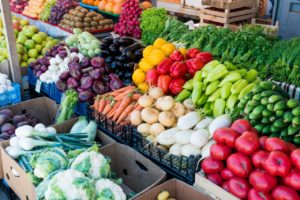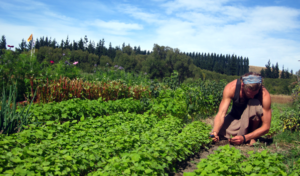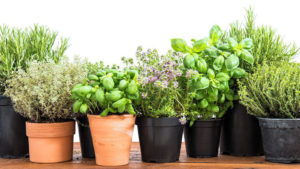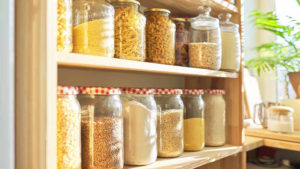Healthy eating is hard enough in a brick and mortar with refrigeration never mind when you don’t have all the amenities of home so to speak. As nomads we face these challenges every day. Here are some tips and shared knowledge to help us eat as healthy as we can while traveling.
Seasonal Foods
 One of the most helpful ways to eat healthy is to eat local and seasonal. Everywhere we travel there are produce stands, farms, pick-your-own fields and farms, local fruit and vegetable festivals…the list goes on. If you do have a refrigerator, buying as fresh as possible also allows for longer dry storage which keeps your refrigerator as empty as it can be. Seasonal foods are not only better for you, they tend to be less expensive than the average grocery store foods. Examples of eating seasonally to save money are:
One of the most helpful ways to eat healthy is to eat local and seasonal. Everywhere we travel there are produce stands, farms, pick-your-own fields and farms, local fruit and vegetable festivals…the list goes on. If you do have a refrigerator, buying as fresh as possible also allows for longer dry storage which keeps your refrigerator as empty as it can be. Seasonal foods are not only better for you, they tend to be less expensive than the average grocery store foods. Examples of eating seasonally to save money are:
Winter – In the southern warmer states there isa winter growing season. Cold hardy vegetables like brussel sprout, cabbage, cauliflower and broccoli are all grown in the south in winter. Ground vegetables like radishes, potatoes, beets and carrots. In Central and South Florida farmers plant greens, legumes and strawberries as well. Of course strawberries should be eaten within a day or two if not refrigerated.
Spring – eggs are quite abundant in the spring and prices tend to be lower. Buying fresh eggs from a farmer may seem expensive sometimes but the shelf life of unwashed eggs is 3-4 times that of mass produced eggs in the big chain stores.
Summer – Fresh greens and vegetables are most all in abundance during summer. Of course this depends on what growing zone you are traveling through. The wealth of vegetables available in summer also allows for less consumption of meats which require more refrigeration than vegetables.
Autumn – Autumn is when most meats are ready for slaughter after fattening up all summer. Of course meat will require refrigeration or canning. There are tons of different vegetables and fruits that come to harvest in Autumn as well. Cranberries, apples, pomegranates, citrus fruits, pears grapes , and blueberries all come to mind. Vegetables like arugula, broccoli, spinach, kale, celery, and artichokes as well as most grains are harvested in Fall. Be on the lookout for root vegetables like squash, onions, carrots and turnips which all store very well without refrigeration.
 Below are some links to help find farms and markets for local fresh sourcing. These are nationwide sources and only a beginning of what can be found out there:
Below are some links to help find farms and markets for local fresh sourcing. These are nationwide sources and only a beginning of what can be found out there:
https://www.localfarmmarkets.org/
https://www.usdalocalfoodportal.com/
https://sustainableagriculture.net/blog/national-guide-to-finding-local-food/
Herbs
 Herbs can be grown in pots year round even in the most limited of spaces and have many health and medicinal values. Easy to grow herbs include basil, cilantro, thyme, rosemary, parsley oregano and mint can be grown in small pots right in your rig as you travel.
Herbs can be grown in pots year round even in the most limited of spaces and have many health and medicinal values. Easy to grow herbs include basil, cilantro, thyme, rosemary, parsley oregano and mint can be grown in small pots right in your rig as you travel.
Food Storage
Be sure to buy foods that have a reasonably long shelf life if you have no refrigeration. Some of the best foods that keep the longest and require no refrigeration are of course canned and boxed foods. Homemade breads generally keep longer than store bought brands and tend to dry out before molding in drier climates so they are great for making croutons, stuffing and french toast. Some other foods that do not spoil quickly are:

Honey – honey is the one food that NEVER goes bad. Why is this? Mainly because honey has a very low water content which keeps bacteria from growing.
Mustard – more flavorful and better for you than mayonnaise, mustard will stay a very long time unrefrigerated. If you must use ketchup or mayonnaise I have found it best to buy those little individual serving packets (or just grab a few next time you are in the grocery store while ordering a sub from the deli).
Garlic and onions will stay a very long time with out cold storage. Always keep onions away from other vegetables as they will cause them to spoil quicker. This is due to gasses emitted by the onions.
Apples – apples will stay for a very long time (2-3-weeks easy) without refrigeration.
Hard and Waxed Cheeses – Certain cheeses such as parmesan and Romano as well as waxed cheese will stay for quite a while except in very hot climates.
Average Food Storage Lengths
Dry foods –
 Brown and wild rice will stay good for about 6-8 months but white rice is good for 3-5 years.
Brown and wild rice will stay good for about 6-8 months but white rice is good for 3-5 years.
Oats and Quinoa will stay up to 3 years
Pasta will stay good for a couple years if sealed well. After that it will start to degrade and lose quality. Weevils may show up in store bought pasta after a year or so.
Flour usually stays good about 6 months in its original packaging but will last up to 10 months in an airtight container.
Dried beans and legumes – These will store indefinitely. After about two years they will lose some of their vitamin properties but the portion and mineral contents stay forever.
Nuts and Seeds – most nuts can last up to 9 months in the pantry, except for pecan, pistachios, and walnuts. They’ll stay fresh for between 3- 6 months. Chia seeds will be perfectly fine for 2+ years in the pantry, Flax seeds are good for up to 12 months and sunflower seeds will stay fresh up to 3 months raw and 6 months roasted.
Dried Fruits are generally good up to a year in the pantry.
Note: There are many good tips for preparing and storing foods in vintage cookbooks. After all, they didn’t have the amenities that most do today. Keep and eye out for them at used bookstores, garage/estate sales and the next time you go thrifting.
About Sodium and Processed Food-like Substances
Be sure to not eat heavily processed foods. Also keep in mind that most commercially canned foods are loaded with salts and other preservatives. It is always best to purchase low sodium and organics when buying pre-canned foods.
On top of the list for high sodium and processed foods are the garbage they call food that they push upon us in fast food chains and convenient stores. These are among the most unhealthy food sources available.
Food Preservation
Canning can be difficult on the road but if you are stopping somewhere for a while, and have a stove, canning can be a great way to store foods. No matter what anyone says, cold caning is not a safe way to store meats. Afterthought – planning a “pick your own food tour” and canning as you go is a great way to keep the pantry full and very economical.
I’m not going to go into it deeply here but pickling and fermenting foods is also a viable option. Grab a book or search the internet for more about these processes. I think you’ll find it interesting at least.
A food dehydrator can be used to extend shelf life of many foods. Freeze drying is the best way to store foods for long term but is not very practical because of the space and power required plus the machine to do it is quite expensive. Dehydrators can be purchased quite reasonably and are one of the best ways to store meats, think beef jerky.
In Conclusion…
Changing eating habits, just like changing living quarters, is not just eating healthier foods, it is a lifestyle change. These type of things take time, discipline and learning. Be easy on yourself and don’t expect to follow all of these suggestions at once. Prioritize and gradually transition into the most healthy and economic nomad you can be.

